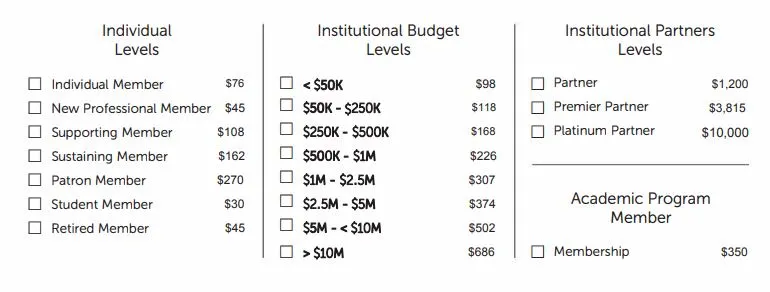![A Comprehensive Guide to Membership Pricing for Associations [Including Pricing Models, Successful Strategies, and FAQs] A Comprehensive Guide to Membership Pricing for Associations [Including Pricing Models, Successful Strategies, and FAQs]](/sites/default/files/2024-08/a_comprehensive_guide_to_membership_pricing_for_associations_including_pricing_models_successful_strategies_and_faqs__%281%29.webp)
Choosing a membership price that generates significant revenue without not driving away your potential members is often challenging.
Another factor that is equally important is the payment structure. Should you ask for a one-time upfront payment or subscriptions that need to be renewed every year?
In this article, we will guide you step-by-step on how to price your memberships that will truly reflect your value without intimidating your members.
We will also discuss various membership pricing models with guidelines for selecting the right one. In the end, we will also explore the best strategies to optimize your pricing structure with examples from well-known organizations.
Let’s get started.
Key Takeaways
- The core principle of membership pricing is to match the price to the value provided. Use the formula: Value × Stickiness × Confidence = Average Revenue Per Member to calculate a baseline for your pricing strategy.
- There are multiple pricing models to choose from, including lifetime memberships, fixed-term pricing, group memberships, freemium, and flexible pricing. Each model has its pros and cons, and the choice depends on your association's goals and member demographics.
- Organizations that review and update their pricing structures twice a year tend to earn almost double the average revenue per user compared to those that only adjust annually. Regular reviews allow you to adapt to changing market conditions and member needs.
- Develop your pricing strategy based on market research, competitor analysis, and member feedback. Use tools like A/B testing and price sensitivity analysis to optimize your pricing over time.
- Communicate the value of your membership to potential and current members. Be transparent about where membership dues are allocated, highlight the return on investment, and use visual aids to explain different membership tiers and benefits.
How to Calculate Membership Pricing Using a Formula?

In order to determine your membership fee, you must first estimate what your potential members are willing to pay.
Let’s take this membership pricing formula:
Value X Stickiness X Confidence = Your Average Revenue Per Member
Step 1: Calculate the Value Consider how much value your membership will provide for one member. Additionally, you can take a look at your competitors and find out what their average fee is for each value.
Step 2: Calculate Stickiness Determine your stickiness value with questions like, “what is the benefit of your membership? Does it solve a long-term issue or have short-term benefits?”.
To get this number, estimate how long someone will stay on board with you.
Step 3: Calculate Confidence An estimation of how much money your members will be willing to spend is confidence.
For example, if you are providing value worth $5000 to your members but you don’t think they would pay that much, adjust the confidence value down to something that feels more reasonable.
You can calculate this number by dividing the total value of what you deliver by the percentage someone would pay. If you think someone would pay $250 for the $5000 value, then the number would be 5% or .05.
Example of this membership pricing formula in action:
Value (5000) x Stickiness (3 months) x Confidence (0.05) = $750 (Average Lifetime Revenue Per Member)
That makes your monthly membership fee set to $250/month, considering that they will pay this value in three months.
Here are some factors you need to consider when calculating the core elements in the membership pricing formula:
Match the Price to the Value
The number one rule of pricing your subscription is that it should reflect the value that you are providing. An easy way of determining this is to assign points to each benefit/experience and add them all together.
Another thing to consider here is the duration in which members will receive the value. Is it going to be delivered evenly over the lifetime of the membership? If that’s the answer, charging an annual or monthly fee makes more sense.
In cases where most of the value is delivered within the first three months of a membership, it is smart to charge a one-time upfront payment.
Calculate your Expenses
A successful pricing model includes all the expenses that are involved in running an organization. Therefore, make sure you consider all your spending before deciding on a fee for each tier.
Revenue – Costs = Profit (net income)
Your expenses will include resources used on day to day basis, rent of office and equipment used, salaries of your employees, cost of your association management software, and the cost of running events and projects.
The membership fees of some organizations cover 100% of their expenses. Others rely on fundraising, grants, and sponsorships to cover their expenses. Whereas, some nonprofits work on a donation basis, charging little or no membership fees.
On top of these costs, think about any other inputs like your own time or anyone you might hire to help manage or run the membership.
Find What Membership Pricing Model Is Best for You
After you calculate the ideal fee you need to set for your memberships using the pricing formula, determine which pricing model will help you get the most subscribers.
For example, if your membership fee is high, you might think about including installment plans in your model. Alternatively, offering umbrella plans would be ideal if your fee lies within the affordable range and you expect more revenue from group registrations.
Here are some of the member pricing strategies that you can use to get the most out of your offerings.
Types of Membership Pricing Models
1. Lifetime Memberships (One-Time Upfront Payment)
As the name indicates, a lifetime membership pricing model includes a one-time payment and your members can retain their subscription for life. As enticing as it seems, it has many drawbacks, like:
- Low member engagement over time
- No sustainable revenues for business
Additionally, it can make your model look overpriced, leading to fewer memberships.
However, The Lifetime Membership program offers an opportunity to the alumni associations as they keep members in the loop even after they’ve graduated from college, or retired from a job.
2. Fixed Term Pricing (Annual or Monthly Fee)

According to this pricing model, all membership levels have a set expiration date and require members to renew in order to maintain their memberships.
Usually, this pricing structure is used for a set calendar year (January 1 to December 31). It is the most popular membership pricing model for traditional associations and benefactor groups.
However, it can be made more attractive by offering early renewal discounts, a multi-year membership discount, or prorated memberships for midterm sign-ups.
For more reading on this model, see:
- 6 Strategies to Increase Membership Renewal Rates in Associations
- 20 Effective Membership Retention Strategies & Ideas
3. Group membership (Umbrella Plans)
Group memberships are suitable for B2C membership organizations such as gyms, social clubs, and professional societies where people join as a group.
The model offers a lower fee on each membership to subscribe as a group. Alternatively, you can charge a collective membership price that is much lower than the sum of all memberships.
The benefit of this approach is that it makes membership more affordable and that it grows your community and revenue at the same time.
4. Freemium

Freemium is a popular pricing model nowadays. Derived from the words, free and premium, it involves free registration with additional costs for the advanced features. It is a great model because it gives members freedom and allows them to pay only for the benefits they want. In general, members are more likely to see value in their membership when they don't feel like they're paying for something they won't use.
If your financial model doesn’t allow you to offer a freemium, you can charge a small registration fee or a renewal fee with service charges for each add-on. As a result, you will be able to cover your basic expenses and provide value to your members.
6. Flexible Pricing Model (Pay What You Want)
This model is popular in nonprofit organizations where the people you are serving cannot afford to pay a higher subscription fee. In this pricing plan, you ask your members to pay whatever they can.
However, to maintain the financial health of your association, you will need to seek grants and donations from your sponsors.
Regardless of your industry, you can use a flexible subscription model for your membership site. In this case, the option of accepting donations can be an effective way to make a modest income without being compelled to become a member.
7. Installment Plans
The model is useful if you need to charge a high fee but know that your customers cannot afford it all at once. It is best used in educational and training associations.
One drawback of the installment plan is that they can cancel their memberships at any time without making complete payments.
As an example, if you give them member benefits worth $400 during onboarding, and they cancel their membership in the second month, you're out a lot of money. So make sure that you include the following four components in your installment plan pricing model.
- Initial Payment: $200 (that would cover at least half of the member expenses)
- Recurring Subscription
- Billing Cycle Limit
- Expires in (mention the time period)
How to Develop an Effective Membership Pricing Strategy?
Consider Market and Customer Data
To set a fair fee for your membership tiers, consider both your competitors’ and customers’ data.
Your market and competitor’s data are extremely useful when you first set a price for your memberships. However, as time goes on and you learn more about your customers, you may discover that the value of your membership is quite different from what your competition is offering.
The model you ultimately decide to use should thus be driven by true data. You can easily underprice or overprice a membership if you don't rely on solid evidence.
Revisit Your Prices Twice a Year
According to Hubspot, an organization that reviews and updates its pricing structures twice a year earns almost double the ARPU (average revenue per user) as one that only adjusts it annually.
This is important because as you improve your member experience at your association, you will need more digitalization resources which will demand more funds.
Thus, you should revisit price plan of your membership/association dues as you offer improved versions of your product to your members.
Identify the Core Revenue Drivers
Many organizations think that competitive price is the only revenue driver, which is not true.
There are several activities that must be driving more memberships like paid ads, member referrals, events, website content, or EDMs. The key is, to identify the two main core revenue generators which bring in the most subscriptions and increase your budget on those activities.
You can also include them in your annual costs to measure your net profit and decide what you want to charge for each tier. Furthermore, you can determine which tactics work best on that particular channel and how you can make it more efficient.
Read more: How to Create a Member Referral Program that Drives Membership Growth?
Do Not Ignore Your Non-dues Revenue Streams
Identifying your core revenues doesn’t mean that you forget your secondary revenue streams.
Look for other ways to make revenue instead of asking your members to pay more once again when you need more funds. It will be appreciated by your members and they will be more likely to stay loyal and committed to your organization.
The following are some excellent non-dues revenue streams:
- Fundraising activities particularly capital campaigns
- Event sponsorships
- Selling merchandise
- Grants
Analyze your Member Base
Take a moment to consider your existing members or the types of members you would like to attract. What is their age group? Why would they join your association? What benefits they are looking forward to?
Setting a membership fee requires answering all these questions. They will not only help you determine how much they are willing to pay for your memberships but what type of pricing model will appeal to them most.
For instance, if your potential members are college graduates yet looking for a job, setting a high fee for your subscription might be unaffordable for them. In such cases, the ideal model would be freemium.
On the other hand, if your association targets businesses and successful entrepreneurs, having a lifetime membership or a fixed-term subscription pricing model will be the best option for achieving long-term engagement.
Read more: 50 Proven Member Engagement Ideas for Associations
Make a Free Trial Available

Even though a free trial may seem like a waste of time, it can help you optimize your membership pricing strategy. People are more likely to stick around long-term if you give them a taste of what's to come when they join as full-fledged members. You can offer a free or discounted membership trial for a short period of time, such as two weeks or one month.
Show Your Benefits With the Price

Most websites don’t show their spending against each tier which often makes it difficult for members to find its value. The right way of doing this is to design a separate page for each membership level that states the benefits with a separate form for each tier.
Provide a breakdown of where your membership fee will be used so that your members know where their hard-earned money is going.
With Glue Up membership management software, you can design a separate digital membership application form for each tier that represents the breakdown of the fee and the benefits. As a result, your members can relate the fees with the value you provide and hence increase your member acquisition rates.
The software also allows you to automate your member acquisition workflows to accept payments and generate an invoice on your behalf. This way, you can focus on strategizing rather than spending your time on routine tasks.
Get a demo to discover how more digital solutions for improving all the stages of your membership cycle including registrations, engagement, and renewals.
Membership Naming Strategy
One of the key aspects of developing an effective membership pricing strategy is to name your membership levels in a way that resonates with your association’s goals and vision. By choosing names that reflect your association’s values, you can communicate what your organization stands for and what benefits your members can expect.
For example, if your association is focused on environmental sustainability, you can name your membership levels “Green Advocates” or “Sustainability Champions” to highlight your commitment and impact.
Additionally, by naming your membership levels in a way that invokes a sense of community, you can create a feeling of belonging and connection among your members. This can help you attract and retain members who share a common interest and identity.
For instance, you can name your membership levels “Industry Insiders” or “Creative Collective” to emphasize the exclusive access and collaboration opportunities that your members enjoy.
Testing and Optimizing Your Pricing Strategy
Developing an effective pricing strategy is an ongoing process that requires continuous testing and optimization. Here are some key steps to refine your approach:
1. Implement A/B Testing
Create two or more variations of your pricing structure and present them to different segments of your audience. This could involve testing different price points, membership tiers, or even how the pricing is presented on your website.
2. Gather Member Feedback
Regularly survey your members about the perceived value of their membership. Ask specific questions about which benefits they find most valuable and whether they feel the pricing is fair.
3. Analyze Usage Patterns
Use your association management software to track which benefits and services are being used most frequently. This can help you identify which aspects of membership are driving the most value and inform your pricing decisions.
4. Monitor Competitor Pricing
Keep an eye on how similar associations are pricing their memberships. While you shouldn't base your pricing solely on competitors, it's important to understand where you stand in the market.
5. Conduct Price Sensitivity Analysis
Use techniques like the Van Westendorp Price Sensitivity Meter to understand at what price points your membership becomes too expensive or too cheap in the eyes of your target audience.
6. Iterate and Improve
Based on the data you gather, make incremental changes to your pricing strategy. Be prepared to adjust not just your prices, but also your membership tiers and the benefits included in each.
Remember, the goal is to find a pricing sweet spot that provides value to your members while also supporting the financial health of your association.
Communicating Your Pricing to Members
Effective communication about your pricing is crucial for member acquisition and retention. Here are some strategies to convey your pricing structure and its value:
1. Be Transparent
Clearly outline what members receive for their dues. Create a detailed breakdown of benefits for each membership tier, helping potential members understand the value proposition.
2. Highlight the Return on Investment
Quantify the value of membership where possible. For example, "Access to our job board, valued at $X per year" or "Discounts on industry events, saving members an average of $Y annually."
3. Use Visual Aids
Create infographics or comparison charts that easily display the different membership tiers and their associated benefits. This can help members quickly understand their options.
4. Explain Price Changes
When you need to increase prices, communicate the reasons. Highlight new or improved benefits, increased costs of operation, or expanded services to justify the change.
5. Offer Personalized Consultations
For higher-tier or corporate memberships, consider offering personalized consultations to explain how the membership can be tailored to their specific needs and provide value.
6. Showcase Member Testimonials
Use testimonials from satisfied members to illustrate the real-world value of membership. This social proof can be powerful in justifying your pricing to potential new members.
7. Provide Clear FAQs
Anticipate questions about pricing and create a comprehensive FAQ section on your website. Address common concerns such as payment methods, refund policies, and upgrade options.
Membership Pricing Examples from Real Membership Businesses
Now let’s take a look at some real-life examples of membership pricing:
Community Associations Institute (CAI)
Community Association Institute offers four types of membership, with fees ranging between $35 to $625. Its potential members include students, management companies, and businesses.

The best part about CAI’s fee structure is that it gives a breakdown of the membership dues to provide a clear picture of their values. There is also a short description for each part at the end that explains where your money is actually invested in.
American Association for State and Local History (AASLH)

American Association for State and Local History (AASLH) has over 15 subscription types grouped into four categories. This makes it accessible to many people, making it available to individual members, institutions, and academic programs.
FAQs
What is membership pricing?
The membership price is the fee collected from your members to provide them with benefits. These are structured into models to decide the amount and frequencies of the payments that would provide them with premium benefits while generating sufficient revenues.
Are membership sites profitable?
Membership sites provide substantial value to your members through your content. You can add member directories, post events, and create a job board. Thus, if your membership site is well-designed with many features, it can motivate people to buy your subscription.



